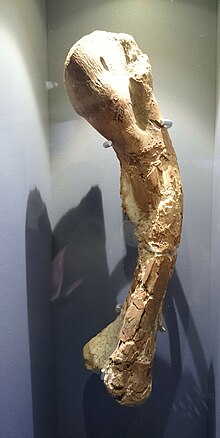|
Kangnasaurus
Kangnasaurus (meaning "Farm Kangnas lizard") is a genus of elasmarian ornithopod dinosaur found in Late Cretaceous rocks of South Africa. It is known from a tooth and possibly some postcranial remains dating between the middle-Campanian to Maastrichtian Kalahari Deposits Formation.[1] Discovery and naming Kangnasaurus was named in 1915 by Sidney H. Haughton. The type species is Kangnasaurus coetzeei. The generic name refers to the Kangnas farm; the specific name to the farmer, Coetzee. Kangnasaurus is based on holotype SAM 2732, a tooth found at a depth of 34 metres in a well at Farm Kangnas, in the Orange River valley of northern Cape Province, South Africa.[2] The age of these rocks, conglomerates in an ancient crater lake, was once suggested to date to the Early Cretaceous (probably early-Aptian) due to the original phylogenetic position of the taxa as a dryosaurid.[3] But a Late Cretaceous age between the Campanian and Maastrichtian is more likely due to sedimentological analyses.[4] Haughton thought SAM 2732 was a tooth from the upper jaw, but Michael Cooper reidentified it as a lower jaw tooth in 1985.[5] This had implications for its classification: Haughton thought the tooth was that of an iguanodontid,[2] while Cooper identified it as from an animal more like Dryosaurus, a more basal ornithopod.[5] Haughton described several other fossils as possibly belonging to Kangnasaurus. These include five partial thigh bones, a partial thigh bone and shin bone, a partial metatarsal, a partial shin and foot, vertebrae, and unidentified bones. Some of the bones apparently came from other deposits, and Haughton was not certain that they all belonged to his new genus.[2] Cooper was also not certain, but described the other specimens as if they did belong to Kangnasaurus.[5] Like other basal iguanodontians, it would have been a bipedal herbivore.[6] ClassificationKangnasaurus was originally regarded as dubious,[7][6] although a 2007 review of dryosaurids by Ruiz-Omeñaca and colleagues retained it as potentially valid, differing from other dryosaurids by details of the thigh bone.[3] The differences in interpretation between Haughton and Cooper regarding the placement of the tooth had implications for the taxon's classification: Haughton thought the tooth was indicative that of an iguanodontid when interpreted as a maxillary position,[2] while Cooper classified it as coming from an animal more like Dryosaurus based on his assignment of the tooth to the dentary.[5] However, more recent studies have separately uncovered a position nested within the elasmarian group.[8][9][10] References
|
||||||||||||||||||||||||||||||||

